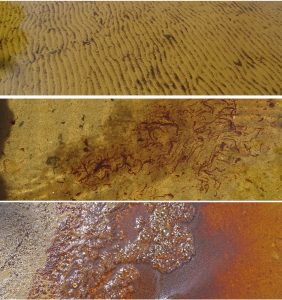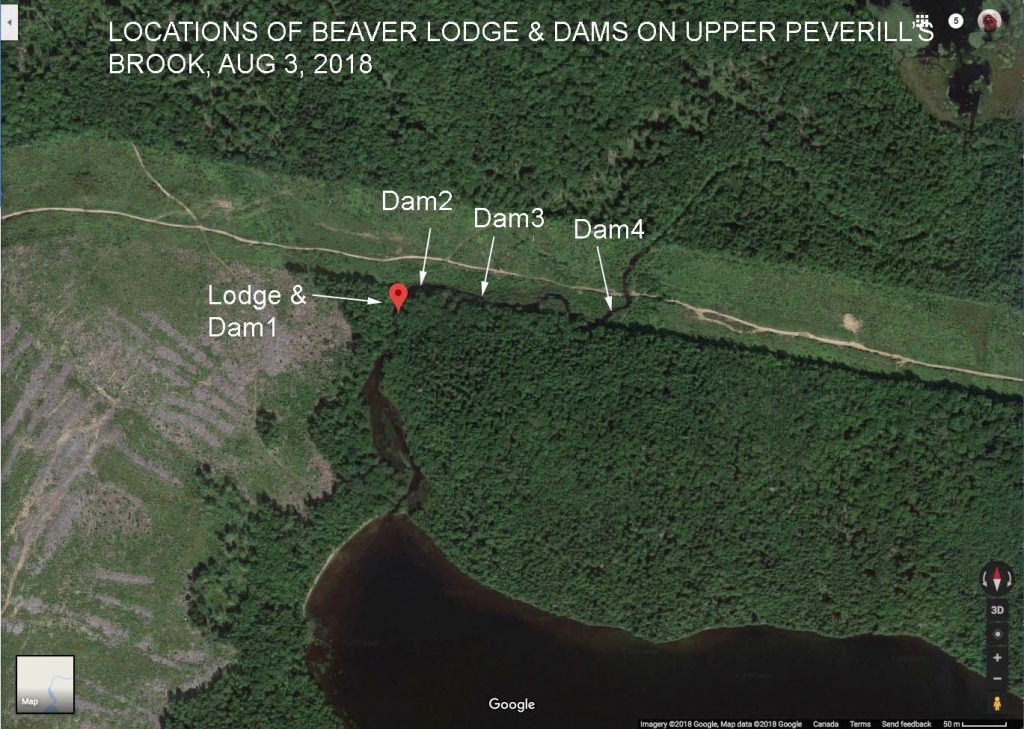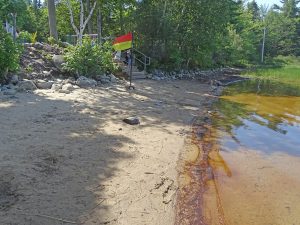I happened to be at Sandy Lake Beach Park on the morning of Aug 6, 2019, shortly after the beach area was inundated with an unpleasant suspended, reddish, soapy material.
It wasn’t there when the lifeguards first arrived. They told me they had first noticed it st about 10:40 am; a lifeguard noted that one of the kids in her swim lesson group “looked like the joker from Batman because he had a brown line around his jaw as we had been treading water and his face was in the water at that level, then I noticed it on one of the other kids and as we moved in shallower, the kids noticed all over my back. At about 10:50 we pulled all of the kids out of the water”.
 I asked when they (the lifeguards) got there- 9:45 a.m., and “It wasn’t here then, and we were in the water at 10 and there was none of it then.”
I asked when they (the lifeguards) got there- 9:45 a.m., and “It wasn’t here then, and we were in the water at 10 and there was none of it then.”
When they paddled out into the lake, there was a wake of bubbles behind them. “It’s on the water, then under”, they remarked. It extended out as far as they paddled, circa half way across the lake.
From the way the material accumulated on the shore and in ripples on the bottom, I got the impression that it was blown into the area, rather than being formed in-situ.
Videos
|
About 1 pm I looked at a site across the lake where the dairy road comes down to the lake. There was no noticeable debris, but the water did bubble when you walked through it as it had at the beach. Later in the day I talked to a local resident on the west side of the lake further to the south, and he said it was “everywhere” and had likewise appeared suddenly in the morning.

Dissection Mic View. The individual particles
are barely visible. Larger aggregations have no
visible cellular structure
I took a sample of the material at Sandy Lake Beach Park and later examined it under a dissection microscope. It seemed to be composed of very fine particles with bits of some sort of gelatinous material and aggregations of the same; I could see motile unicells about the same size as the very small particles, and some larger protozoa (circa 1/3rd of a millileter in length) moving through the material. It did not seem to be pollen or algae. However it needs to be looked at more critically with a regular light microscope and tested for potential pathogens.
It seems advisable not to swim in the lake until it has been properly tested and is finally clear of this material; if not toxic, it is definitely unpleasant!
 I submitted a brief report on the above to https://www.theswimguide.org/report/?id=5582 this a.m., and notified Councillor Tim Outhit.
I submitted a brief report on the above to https://www.theswimguide.org/report/?id=5582 this a.m., and notified Councillor Tim Outhit.
Kudos to the lifeguards/swim instructors for prompt action in advising people not to swim in the lake under these conditions.
———
ADDENDUM 9:32 am message from Tim Outhit:
I was just advised that HRM is presently engaged in this situation and is following a preset guideline for sampling and testing. They are also advising N.S. Environment.
I have requested an update media statement from HRM that I can share residents today.
Thanks for the quick follow-up, Tim.
10.00 am: I was just told by beach personnel that ‘the lake has dropped probably another 2-3 inches, the brown stuff is still there, HRM took water samples this morning, and a NO SWIMMING will be put up shortly’.
———-
Falling Lake Level
Possibly related, possibly not: the lake level had dropped a lot in the last week. The resident on the west side I talked to said it had dropped by about a foot in the last week. The lifeguards showed me how much the beach had extended just since the day before, and that corresponds to a 2-3 inch vertical drop.
The lake was much higher than normal in 2018 which was attributable to beaver dams being constructed on upper Peverill’s Brook which drains Sandy Lake (view Beavers/Sandy Lake water level.
Earlier this summer, the level was lower than in 2018, with a beach re-appearing where there had been none in 2018. About 12 days ago, I was talking to a fisher who knows the lake well. He had been down to the outlet, and said the beaver dams were still there. He attributed the lower water level to lack of rain.
There was well above average rainfall in June of 2019, and well below average in July, so some of the high water level earlier and rapid drawdown in 2019 may have been weather related.
However, the precipitous drop in water level over the past week calls for another examination of the state of those beaver dams.

=======
UPDATE (Jan 31, 2021): I was told later that one of the dams, believed to have been an old (not maintained) one was legally removed by DNR in late July of 2019 because of concerns of the Sackville River Association about its possible effects on migratory fish returning to Sandy Lake.
Here is the rainfall record for 2019 at Stanfield International Airport:

There was well above average rainfall in June of 2019, and well below average in July, so some of the high water level earlier and rapid drawdown in 2019 may have been weather related but it seems very unlikely that it could have accounted for the precipitous drop in water level, as cited above, a “a 2-3 inch vertical drop” the day before the algal bloom appeared.
A possible mechanistic link between the rapidly falling water level and the algal bloom
The co-occurrence of the the drop in water level and the transient bloom may be “just coincidence” as they say.
However here is a possible mechanism: the removal of the dam resulted in a sudden increase in flow of water in the surface layers of the lake and caused some disruption in the thermocline/vertical stratification as can happen in reservoirs when water level is lowered ( Nowlin et al, 2004); this occurred at a time when the hypolimnion oxygen was near minimal seasonally; there had been some release of phosphorus from sediments in the hypolimnion associated with low oxygen (re: AECOM 2014, p. 22-23), some of the phosphorous was transferred to the epilimnion (reduced in volume by the water drawdown) when surface water temperature was high and favourable for algal blooms, and a bloom occurred. Like the change in water level and increased flow, however, the algal bloom was short lived.
On Dec 12, 2020, I walked by the area where one of the dams had been located, and it had been rebuilt* however, with quite of bit of flow around it on the floodplain:
_________
*Or perhaps it had not been removed; it was dam #3 in the photo above, dam #4 was the biggest structure with the largest head of water – see Beavers/Sandy Lake water level, and associated photos.
I contacted the SRA and told them that the dam had been rebuilt (or at least appeared to have been rebuilt): they told me that “we did see evidence that gaspereau had gotten past this dam and were above the structure with passage to the lake – there were a number of side and runaround channels that formed as the high water levels found new paths around this structure in the run section of the river along the power line downstream from the lake outlet”, further that “The effort taken was worth while when it was thought that the structure was abandoned, and improving fish passage was warranted by removing the debris jam that the dam had become, but now that it has been rebuilt and is an active dam, further work is more difficult to justify given that there is (or at least was last we had observed) fish passage around this structure.”
——–
Also view
– Advisory issued for Sandy Lake due to possible blue-green algae bloom Aug 7, 2019 & Update: “2:35 pm, Thurs Aug 8, 2019: Risk advisory for Sandy Lake lifted”
– Water quality issue at Sandy Lake Bedford has subsided (Aug 9, 2019): “info forwarded by Councillor Tim Outhit, received from Cemeron Deacoff (Water Resources Specialist, Planning and Decelopment, HRM) on Thurs, Aug. 8:
We received the lab results late yesterday afternoon that the specimens identified in the lab were principally diatoms (a form of algae), with trace amounts of one species of cyanobacteria that does not produce any toxins. Correspondingly, staff (i.e., P&D Acting Director Eric Lucic) has approved lifting the PSA. Corporate Communications is now drafting that PSA…



